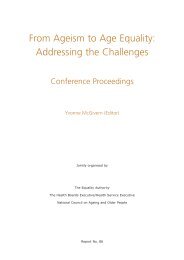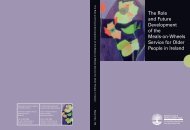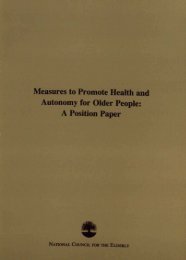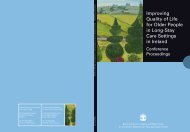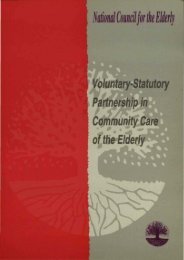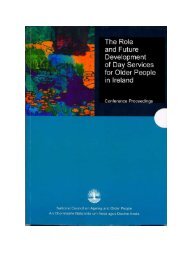Improving Quality of Life for Older People in Long-Stay Care ...
Improving Quality of Life for Older People in Long-Stay Care ...
Improving Quality of Life for Older People in Long-Stay Care ...
- No tags were found...
You also want an ePaper? Increase the reach of your titles
YUMPU automatically turns print PDFs into web optimized ePapers that Google loves.
<strong>of</strong>ten not designed to meet the specific needs <strong>of</strong> residents. For example, althoughall <strong>of</strong> the homes surveyed had beds on more than one floor, only one third <strong>of</strong> thebuild<strong>in</strong>gs had lifts. In addition, handrails were rarely fitted <strong>in</strong> sitt<strong>in</strong>g or d<strong>in</strong><strong>in</strong>g roomsand ramps were provided as an alternative to stairs <strong>in</strong> less than half <strong>of</strong> all homessurveyed. There<strong>for</strong>e, the physical design <strong>of</strong> the nurs<strong>in</strong>g homes tended to engender<strong>in</strong>creased dependence rather than to facilitate or promote greater <strong>in</strong>dependence<strong>of</strong> residents. In relation to staff<strong>in</strong>g, the results revealed that the ratio <strong>of</strong> full-timeequivalent nurses to residents was higher <strong>in</strong> private nurs<strong>in</strong>g homes than voluntaryhomes. The study also noted the high number <strong>of</strong> nurs<strong>in</strong>g aides employed by bothtypes <strong>of</strong> home.The qualitative study (O’Connor and Thompstone, 1986) was undertaken <strong>in</strong> arepresentative random sample <strong>of</strong> twenty nurs<strong>in</strong>g homes. Almost three quarters <strong>of</strong>residents reported that they were contented liv<strong>in</strong>g <strong>in</strong> a nurs<strong>in</strong>g home while just overa quarter were unhappy or felt isolated. More women than men reported feel<strong>in</strong>gs <strong>of</strong>happ<strong>in</strong>ess or contentment. The residents reported that the best features <strong>of</strong> liv<strong>in</strong>g <strong>in</strong>a home were the security and protection it provided and that the residents’ day-todayneeds were looked after leav<strong>in</strong>g residents free to enjoy their retirement. Negativeaspects <strong>of</strong> liv<strong>in</strong>g <strong>in</strong> a nurs<strong>in</strong>g home cited by residents <strong>in</strong>cluded a lack <strong>of</strong> ‘real homelife’, loss <strong>of</strong> friendships and loss <strong>of</strong> control over daily aspects <strong>of</strong> their lives.51In 2003, Age & Opportunity commissioned a small-scale, yet pioneer<strong>in</strong>g study toelicit the views <strong>of</strong> residents on social ga<strong>in</strong> and quality <strong>of</strong> life <strong>in</strong> three long-stay caresett<strong>in</strong>gs – two were run by a health board and the third by a religious order. The<strong>in</strong>stitutions were selected to reflect the variety <strong>in</strong> type and geographical sett<strong>in</strong>grather than be<strong>in</strong>g representative <strong>of</strong> all Irish long-term residential care sett<strong>in</strong>gs.The research identified ten quality <strong>of</strong> life doma<strong>in</strong>s:Companionship and lonel<strong>in</strong>ess – many residents had experienced lonel<strong>in</strong>essprior to mov<strong>in</strong>g to residential care and the availability <strong>of</strong> companionship <strong>in</strong>residential care significantly contributed to the quality <strong>of</strong> life <strong>of</strong> residents.However, some residents still experienced lonel<strong>in</strong>ess, <strong>in</strong> particular residentswho suffered from a hear<strong>in</strong>g or communication impairment, or <strong>in</strong>dividualswho had no shared <strong>in</strong>terests with other residents.Personal identity and privacy – residents’ personal identity was commonlyexpressed <strong>in</strong> their personal space and the ability to have their personalpossessions near them. Private rooms were important <strong>in</strong> order to ma<strong>in</strong>ta<strong>in</strong>personal identity and, thus, significantly contributed to quality <strong>of</strong> life. Theabsence <strong>of</strong> privacy and space <strong>for</strong> personal belong<strong>in</strong>gs underm<strong>in</strong>ed the quality<strong>of</strong> life <strong>of</strong> residents.







